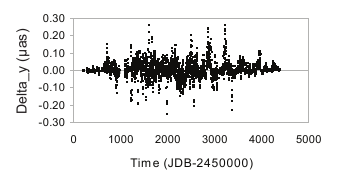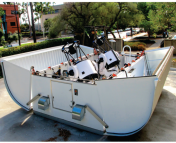Title: The Extreme Stellar-Signals Project III. Combining Solar Data from HARPS, HARPS-N, EXPRES, and NEID
Authors: Lily Zhao et al.
First-author institution: Flatiron Institute
Status: preprint on arXiv
The radial velocity (RV) method of planet detection has been very successful in the 30+ years of its use. The method relies on measuring the motion of the host star due to the gravitational influence of its planet(s). Specifically, we look for the Doppler shift in absorption lines within the spectrum of the star. As the star moves towards us in its tiny orbit around the shared center of mass with its planet(s), the spectrum of its light will be slightly blue shifted. And as it moves away from us, its spectrum will be redshifted. If we can measure a repeated cycle of blue and then red and then blue shifts again and again, we infer the existence of a planet around that star.
It’s a really neat method that has worked really well. However, in practice it is not so simple. Stars are very “active”: starspots, plages, flares, prominences, radial oscillations, granulation, and more are physical phenomena that are produced by the swirling magnetic fields, high temperatures, and other physics associated with stars. These phenomena cause changes in the stellar spectrum themselves, sometimes including red and/or blue shifts. So if we are not careful, we may measure a blue/red shift and mis-attribute it to a planet when it truly originates from activity, or vice-versa.
The problem of stellar activity mimicking or masking planet signals causes a lot of difficulties when planet searching via the RV method. Activity is a nuisance which we attempt to model and subtract out of our data but this is not so easy to do. Improper stellar activity modeling can introduce all kinds of unwanted effects into a data set and make planet detecting even more difficult. So if we want to better learn how to identify and model stellar activity, we need to find a way to ensure that we know exactly which signals in a data set are planets and which are activity. Then we can learn how to separate the two and the methods developed along the way can be applied to other data sets where we don’t intrinsically know the answers.
But what data set exists where we know all the signals and their origins? Well…our Sun! Yes, our Sun is the perfect laboratory to experiment on our abilities to distinguish and remove stellar activity signals from planet signals. For one, we know exactly how many planets are in our Solar System (in this case, technically all bodies with mass in the solar system contribute…so Pluto counts!) and their exact orbital parameters. Therefore, we are able to precisely predict the ideal measured RV at any given time due to the motion of the planets. And second, since we can actually observe the Sun up close, we know exactly when there are star spots or plages on the face of the Sun, when a flare goes off, and more. Observing the “sun as a star” is like having all the answers at the back of the textbook.
This idea is not a new one, but it has only recently become feasible. The newest generation of planet-searching RV spectrographs, HARPS in La Silla, Chile, HARPS-N in Grand Canary Island, EXPRES near Flagstaff, AZ, and NEID outside Tuscon, AZ, all of specially made solar telescope feeds so that they can take RVs of the Sun during the day time when the instrument would otherwise not be in use. It’s free RVs! And since they are spread out all over the world, see Figure 1, at least one of them is always taking measurements of the Sun! Today’s astro-ph paper is a group effort across the instrument teams for these 4 instruments. The paper uses the solar data from these 4 instruments begins to compare the measurements to see if they’re all in agreement.
The authors take a 1 month period of solar data in May and June 2021 for each of the four solar RV telescopes. Because all the observations are taken at slightly different times, the authors applied a sophisticated binning technique to make the data tractable. Overall, they report that the 4 data sets are generally in very good agreement with each other, finding that all combinations of pairs of instruments agree within 15-30 cm/s within the same day, which is about the single measurement precision of each data point. This is great news because it means that the signals being detected by each of the instruments are most likely astrophysical in origin, not instrumental. If there were prominent instrumental effects, the data sets would differ from instrument to instrument.
However, they find that from day to day, the scatter between instruments increases to ~60 cm/s. This means that some instrumental effects are playing out over longer baselines. The authors suggest that this extra noise might be due to the differences in the way that each instrument produces RVs. They use slightly different pipelines to compute the RV from the raw spectrum, and they each have slightly different ranges of wavelengths being used to compute the RV. The authors recommend that one common pipeline be developed to hopefully zero out these effects. They also suggest that differences could be due to the different local times at the different observing sites for the same timestamped RVs: the instruments in AZ might be observing the Sun while it is high in the sky at local Noon while the instrument in the Canary Islands is seeing the Sun much closer to the horizon. This second case causes an overall reddening of the spectrum, called extinction, and can cause the computed RV to be off from what is expected.
The authors conclude by stating that we are about to enter a very exciting time in solar RV science. New spectrographs are about to come online and they all have solar telescopes attached to them meaning soon we will have even more data sets to compare and truly cover the entire globe. Next, the data used in this study was taken fairly close to the previous minimum of the 11 year Solar Cycle. Soon, in 2024, the Sun will be at Solar Maximum and there are predicted to be a lot more stellar activity and the phenomena associated with it. This would be a great time to repeat this experiment.
While the techniques and methods to separate activity and planets are still on-going, our greatest tool may be our closest star, our Sun!
Edited by Lindsay DeMarchi
Featured image credit: NEID science team




